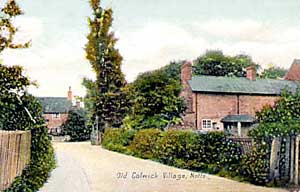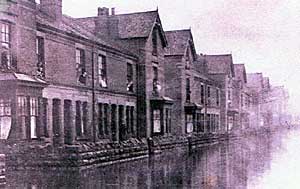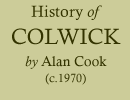< Previous | Contents | Next >
1889 up to the present (1970s)

View of Colwick village, c.1910.
Col. Davies only held Colwick Hall and the lower part of the Park area for a short time before he sold them to a Racing Syndicate, who laid out the Racecourse as the present day and it was opened to the Public on the 19th August, 1892. The Hall was also opened as a Public House at the same time (see section on Colwick Hall for more detail)
By the time the first growth of the village had finished in 1893, the population had increased to 600 people. The main occupation, apart from farming, at this period seems to have been on the railway. 1893 also saw the first business come into the village, which was G. Hooton & Son, Dyers and Lace Dressers. Following them came a steady flow of firms who also opened works in Colwick. From 1895 to 1897 Humber & Goddard’s’ Nelson Cycle Co. Ltd. had a factory there, followed in the 1898-1900 period by Wm. Allen & Co. Ltd., Litho Printers, who perhaps used the same building. In 1899, G. Hooton & Son became Hooton, Spray & Burgass, and Archibald Burgass lived in the house at the front of the old factory, which is now used as offices. Also in the same year, William Lawrence & Co. Ltd., began to build their furniture works, which eventually covered a third of the length of Colwick Vale. This firm was founded by the Nottingham Quaker, William Lawrence, in a garret room on Greyhound Street, Long Row, Nottingham, in 1875. When the factory was completed, it was the second largest furniture manufacturer in, Europe.
The beginning of the 1900s the Netherfield Co-operative Society opened their No.2 Branch on Chaworth Road, also the number of shops besides had increased to three. Surgical Hosiery Co. Ltd. were resident 1900-2 and also at the same time came Edgar & Co., Hosiery Manufacturers. In 1902 came the Colwick Hall Gardens Ltd., Manager, George Neal, and Pett & Co. Sports Manufacturer. In 1905, John Henry Sands, Beechwood House (This house had to be pulled down before it fell down about 1950), started an Engineering Firm, which in 1908, was changed to George Sands & Sons, Engineers and Steel Erectors.
An annual event for the school children at this period was the summer tea party, given by Mr. Mason, of Colwick House, and which perhaps finished in 1911, when he retired from the board of managers. Another annual event, which did not stop until the 1930’s, was the catching of eels at what was locally known as “Little Trent”. A Mr. Hopkinson, had his house-boat towed up the river to Holme Lock, behind the tug-boat, Little John, arriving on the Saturday night before the fishing season opened. Until his death in 1915, Mr. John Elnor, Farmer, who resided at what was later the Soap Factory offices, would on the following Tuesday night, have his men harness up two of the horses and go down to Holme Lock, and tow the house-boat up to a position just above the Old Rectory. Mr.Hopkinson and his wife would reside there for the season, catching the eels by putting nets across the river. They obtained their drinking water from a spring which entered the river at this point.
The farm worked by Mr. Elnor, would be the part now covered by the Sugar Beet Factory, and he also worked Manor Farm, with someone living in as a manager. His farm was always known as a model dairy farm, and after his death and before the Soap Factory was opened, a Mr. Oldershaw, started the Midland Model Dairy there. Until later years, the road from the end of the Racecourse as far as the two farms was known as Elnor Road, and is now called Mile end Road.
Sometime in 1909, the 1st Colwick and District Troop Boy Scouts (Baden-Powells) was formed. The Chaplin was the Rector, Rev. Hildesley, Hon. Scout Master — Mr. O. Lynn, Scout Master — T. Holmes, Assistant Scout Masters — H. Ward and B. Swanwick. By 1911, there were 45 members in the troop, which continued until just before the start of the second Great War.
The Parish Magazine was first published and sold in January 1911, at a penny a month, and contained 24 pages plus 4 page cover. The advertisements in the first issue included the following: — F. Henderson, Family Grocer, Colwick Vale — William Holroyd & Son, Builders & Contractors, 37, Annesley Terrace — G. A. Gilman, Joiner & Funeral Director, 14 Chaworth Road — Wm. Roundthwaite, Snr., landscape Gardener, 161, Lightwoods, Colwick Vale. The Census of the same year shows the state of the village as — 228 inhabited houses, 20 uninhabited, 513 males, 547 females, 136 children up to 5 yrs, 187 from 5-14 yrs.
1911, was also Coronation year and the following is a copy of the programme for the day, copied from the Parish Magazine:
The Programme of Festivities for the Coronation of King George V and Queen Mary, Thursday, June 22nd, 1911, at Colwick was as follows.
2.30 pm Public service at the Church
3.0 pm Children Assemble Colwick Hall Grounds
4.0 pm Free tea for Children above 5 and under 14 followed by Sports for Children
5.30 pm Tea for Adults
Menu
Cold Home Cured Ham |
Cold Lamb and Mint Sauce |
Cold Beef & horseradish Sauce |
Tongue |
Cucumber |
Salad |
Stewed Fruits |
Cakes |
Brown & White Bread & Butter |
Tea |
Tickets — 1s. 9d each to be obtained by 15th June
Pierrot Entertainment and Grounds Illuminated
About 210 children were fed, and about 160 adults had tea in the fine old ballroom. Mrs Elnor presented 72 prizes to winners of the sports, and Mr. Linley presented all the children with a packet of candy.
The Rector, advertised in the Parish Magazine, in 1913, for more choir boys. He stated that he paid them out of his own pocket at 1s.4d per month, with a 5s. bonus for each year, to be paid on leaving the choir. Marks were lost for non-attendance at practice or service, talking in vestry etc., and 1d is lost for every 12 points lost.

Floods in Colwick Vale, c.1910.
During the First World War, in 1917, Sir Ernest Jardine, purchased 400 acres of river frontage for a Sugar Works. He also laid down the “Concrete Road”, which was to be the cause of many winter floods on the Vale, as it worked as a dam against the natural flow of the flood waters. The threat of further floods was not removed until the Colwick Sluice Gates were built.
Traffic through the village was a danger to children in 1917, when the motor vehicle was still in its infancy, as on the 10th January, the School Board of Managers passed the following resolution: - “We, the Managers of Colwick Church of England School, are of the opinion that Danger Boards should be placed at each end of the village. Several accidents have occurred to children attending this School. We therefore request the Parish Council to see that the necessary precautions are carried out”.
On the 17th January 1918, an act of Parliament was passed, allowing land at Old Colwick to be used as an Industrial Estate. In 1919, the Colwick Memorial Institute was erected and in the next few years such firms as Armitage Bros. National Benzole Co. Ltd., Nottingham Colwick Estates, Pure Product’s Ltd., Soap Works, Colwick Light Railway and Trent Concrete were established. In 1924, the Anglo-Scottish Beet Sugar was established and by 1927 their second factory was in full production on the Colwick site. 500 people are employed during the “season” processing beet from 1,600 farmers between September and February. Imported raw sugar is refined during the rest of the year with a much smaller staff.
The last representative in the village of the Clarkson family, who must have resided in the village before the first entry in the old Parish Register was made in 1569, Miss Alice Sarah Clarkson, Old Colwick, died on 29th January, 1921.
On the 29th, August 1922, the New Parish Hall was opened, and when the Nottingham and Colwick Estates laid on electricity to the village, this was the first place to be wired up, and the lights were switched on for the first time on Thursday, 15th January, 1925. The installation cost for the Parish Hall was £145, and for the Rectory, £79.2s.3d. Mr. Fred Leeson, Old Colwick, was quoted £30 for bringing the lines through, plus extra for wiring the house. Jardine’s owned the Power Station and a Mr. Vincent was in charge of running it. Also in September of the same year, a public enquiry into the laying of sewers and installation of flush toilets was held in the village. The cost of conversion was to be paid by the ratepayers.
The demand for more social entertainment saw the Vale Social Club, erected on the opposite side of the road from the Parish Hall, in 1926. Besides being licensed premises, with normal indoor games, facilities for tennis and bowls were also provided at the rear. In June, 1926, parish magazine, the Rector, remarked about the speed of traffic on the main road through the village, and the sharp corners at Chaworth road and the Hall Bridge. About four years after this statement was printed, the present hall bridge was opened, and once again the Rector remarked in the magazine, that the danger on the road would be increased by the extra traffic through the village that the new bridge would bring.
In September, 1928 a branch of the Nottinghamshire Free Library was established in the school, and was continued until the village was transferred to the Carlton Urban District in 1935. In 1931, the village was connected up to the Nottingham Electricity supply, the Electricity used for lighting was at the same charge as previously supplied by the Nottingham and Colwick Estates, but the electricity for heating and power was one penny per unit cheaper.
The western half of the parish was taken inside the City of Nottingham in April 1933, and the rest of the parish was transferred from Basford Rural District, to the Carlton Urban District on the 31st. March 1935. This brought to an end the Parish Council, and also all records of its transactions appear to have been destroyed with it. Also in the same year, a new Congregational Church, with 300 sittings, was erected on Parkdale Road. The population about this time was estimated at 2,300, yet in the Nottinghamshire Directory of the following year the figure is given as 4,396.
Owing to the start of the Second World War in 1939, little change was made to the village during the early years under the Carlton Urban District Council. The war made the usual impact, as in most places, such as Static Water Tanks, Emergency Water Pipes at the road side, Air Raid Shelters, the Institute being used as a British Restaurant, and Crittal Luxfer Factory being built next to the Sugar Beet, and producing shell cases and rockets etc., Lawrences changing from furniture to making gliders, wooden airframes, petrol tanks and high speed launches, and Spray and Burgesses processing various kinds of netting for war use.
After the war, the building of houses developed on the woods area, and by the time that that part was made a separate parish in 1950, nearly all the available building land had been used up. In the last ten years someone has attempted to develop Whymsey Lodge Farm, but apart from carving the hillside out for building it has so far been a ‘white elephant’. No new houses were built in the in the Vale area until the 1960’s, and now about all suitable land has been used up. Shortly after the death of Mr. North, Manor Farm, the land that he used to work was sold off to various firms and by 1970, only odd fields were not covered by factories.
During the 1960’s, the Nottingham Corporation, bought the Racecourse and announced that they were going to make a regional sports centre, with a racecourse sailing lagoon boat basin, hotel, public park and recreation grounds. At present only part of the plans have been carried out.
With the year 1971 through, we have seen the closing of such places as the Soap Works, one Petrol Firm closing and a new one expanding, threats of closing at the Sugar Beet still not being carried out, once more we hear the talk of a bypass road to take the traffic off the vale, and the naming of the first Public House to be built in the parish, ‘The Starting Gate’. The only thing which now remains the same inside the ancient boundaries of Colwick, is that it is once more under the control of one Vicar, with assisting Curate, after a period of being split between two other parishes.
